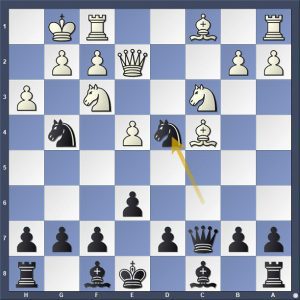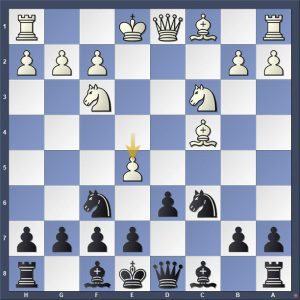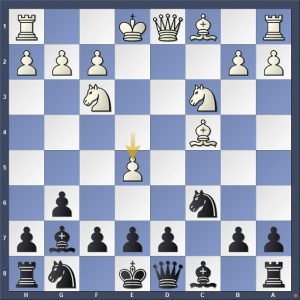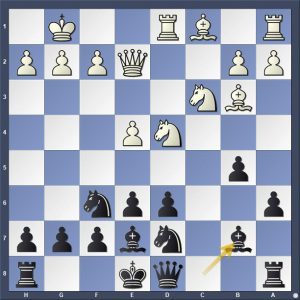In this post I write about what can go wrong when accepting the Morra Gambit without knowledge or when playing subpar variations.
Esserman’s book (see last post) can be considered a decent work which is written in an unconventional and refreshing language. Apart from conveying concrete Morra-knowledge it teaches you about the philosophy of attacking chess in general. While it is definitively an interesting piece of literature, it doesn’t come without shortcomings, though. Esserman simply doesn’t go far enough with regard to the downsides. But this is probably not really possible to include in a book which is supposed to be pro Morra.
If you want to fight an enemy, you first have to get to know and respect him. So, let’s see where the dangers lie. In the introduction, Esserman describes typical winning ideas for White and combines this with pointing out problematic black variations.
a) The problem with the black queen
The opposition of Rd1 and Dd8 is fundamentally unpleasant for Black, since White can exploit it by breaking with e4-e5. This doesn’t work in my recommended lines (see next post), as the pawn is usually left on d7 for a longer period and the knight is only rarely developed to f6.
Moving the queen to c7 doesn’t solve this problem, as White continues the molestation by playing Rac1. This introduces the motif Nd5 exd5 /exd5, pinning the Nc6. On c7, the queen is also exposed to White’s Bf4 after the e4-e5 break. Sometimes, even the profane Sc3-b5 becomes a problem, as can be seen from the example of the “Siberian trap” below. With the following trick, successes could be recorded in the old days:
2..dxc3 3.Nxc3 Nc6 4.Nf3 e6 5.Bc4 Qc7 6.0-0 Nf6 7.Qe2? Ng4! 8.h3 ?? (White has to play 8.g3, but after 8..a6 black is very comfortable) Nd4 – +

Esserman therefore recommends 7.Nb5 (here we have the molestation) Qb8 8.e5! Nxe5 9.Nxe5 Qxe5 10.Re1 with a clear white advantage. Black, however, can improve by switching moves: 5..Nf6! 6.Qe2 (6.0-0 Nxe4! 7.Nxe4 d5 (Esserman)) 6..Qc7 7.e5! Ng4 8.Bf4 and after 8..f6 the position of the queen is exploited again: 9.Nd5! (Esserman). In my recommended variations I usually refrain from playing the queen to c7 at an early stage.
b) The weak point f7
The Bc4 targets our weakest point, which is the f-pawn. This is very relevant in several variations:
3..dxc3 4.Nxc3 Nc6 5.Nf3 d5 6.Bc4 Nf6?! This moves look logical, but after 7.e5! caution is required:

Now 7..Nxe5?? loses the queen after 8.Nxe5 dxe5 9.Bxf7 +. 7..dxe5? is also bad because of 8.Qxd8 Nxd8 9.Nb5 with a clear advantage. The moves 7..Ng4 and 7..Nd7 are playable, though.
Also in the “Morra Dragon” the point f7 is relevant. After 3..dxc3 4.Nxc3 g6 5.Nf3 Bg7 6.Bc4 d6?! 7.Qb3! is very strong according to Esserman, because after 7..e6 the Dragon structure is broken up which results in weaknesses on d6 and f6. 6..Nc6 is better, after which White is forced to continue with 7.e5 to hinder the black development.

After 7..Nxe5? (7..Sh6 =) 8.Nxe5 Bxe5 9.Bxf7+ Kxf7 10.Qd5 + the Dragon bishop is eliminated and White has good compensation for the pawn. Incidentally, I myself have no problems with the weakness of f7, because in my lines the light-squared bishop is always kept in check by the pawn e6.
c) The e6, f7-complex
But even with a pawn on e6 the Bc4 should not be underestimated. Keep in mind that Morra players are not exactly squeamish. In the so-called Finegold Variantion 3..dxc3 4.Nxc3 e6 5.Nf3 d6 6.Bc4 Be7 7.0-0 Nf6 8.Qe2 a6 9.Rd1 b5 10.Bb3 Nbd7 Esserman contributes with two nice victories after 11.Nd4 Bb7?

12.Lxe6!. Black can improve and equalize in several places, but equality is actually not the issue here. After 2.d4 cxd4 3.c3 dxc3 Black has the opportunity to switch into punisher mode and play for an advantage. Since in my variations I start with the pawn structure f7, e6 and d7, the Bc4 doesn’t have very much of a saying.
d) The development of the king’s knight
In section b) we have already seen that the Nf6 can be annoyed by e4-e5. This can be prevented by the Finegold Variation or by a Scheveningen setup. After 3..dxc3 4.Nxc3 Nc6 5.Nf3 d6 6.Bc4 e6 7.0-0 Be7 8.Qe2 Nf6 9.Rd1, however, Black faces the question of how to react to the threat of 10.e5.

Either he plays the blockading move 9..e5 voluntarily or is forced to do so after 9..Bd7 10.Nb5 or 9..Dc7 10.Nb5 Dc7 11.Bf4, respectively. Because of the hole on d5, you wouldn’t have to convince me of White’s compensation anymore. In the diagram position, Black can have a pawn on a6 instead of Nf6 or Be7 and thus play 9..Dc7 without being bothered by 10.Nb5. Then, White replies with 10.Bf4 followed by 11.e5 or 11.Rac1 and 12.Bb3 with the idea 13.Nd5, as already discussed in section a). As we can see, the development of the knight to f6 is not without problems. I simply circumvent it by developing the knight tor e7 and then often further to g6.
